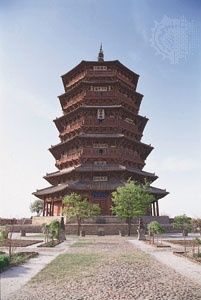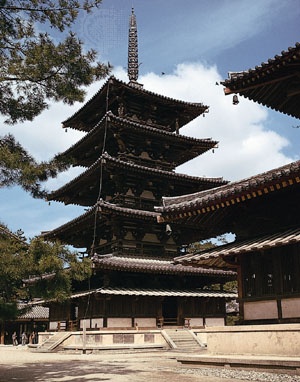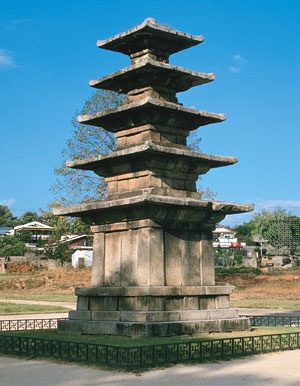pagoda
architecture


 in East and Southeast Asia, a towerlike, multistoried structure of stone, brick, or wood, usually associated with a Buddhist (Buddhism) temple complex. The pagoda derives from the stupa of ancient India, which was a dome-shaped commemorative monument, usually erected over the remains or relics of a holy man or king. The hemispherical domed stupa of ancient India evolved into several distinct forms in various parts of Southeast and East Asia. The finial, or decorative crowning ornament of the stupa, became more elongated and cylindrical until the stupa's upper portion took on an attenuated, towerlike appearance. This stupa form was adopted by Buddhism as an appropriate form for a monument enshrining sacred relics and became known to Westerners as a pagoda. The Buddhist pagoda took pyramidal or conical designs in Burma (Myanmar), Thailand, Cambodia, and Laos; and in China, Korea, and Japan, it evolved into the best-known pagoda form. The latter was a tall tower consisting of the vertical repetition of a basic story unit in regularly diminishing proportions. The stories can be circular, square, or polygonal. Each story in an East Asian pagoda has its own prominent projecting roof line, and the whole structure is capped by a mast and disks. The pagoda form is intended primarily as a monument and often has very little usable interior space.
in East and Southeast Asia, a towerlike, multistoried structure of stone, brick, or wood, usually associated with a Buddhist (Buddhism) temple complex. The pagoda derives from the stupa of ancient India, which was a dome-shaped commemorative monument, usually erected over the remains or relics of a holy man or king. The hemispherical domed stupa of ancient India evolved into several distinct forms in various parts of Southeast and East Asia. The finial, or decorative crowning ornament of the stupa, became more elongated and cylindrical until the stupa's upper portion took on an attenuated, towerlike appearance. This stupa form was adopted by Buddhism as an appropriate form for a monument enshrining sacred relics and became known to Westerners as a pagoda. The Buddhist pagoda took pyramidal or conical designs in Burma (Myanmar), Thailand, Cambodia, and Laos; and in China, Korea, and Japan, it evolved into the best-known pagoda form. The latter was a tall tower consisting of the vertical repetition of a basic story unit in regularly diminishing proportions. The stories can be circular, square, or polygonal. Each story in an East Asian pagoda has its own prominent projecting roof line, and the whole structure is capped by a mast and disks. The pagoda form is intended primarily as a monument and often has very little usable interior space.- Michael William Balfe
- Michael Wiśniowiecki
- Michael Wolgemut
- Michals, Duane
- Michaux, André
- Michaux, Henri
- Michał Bobrzyński
- Michał Choromański
- Michał Fryderyk Czartoryski, Prince
- Michał Fryderyk, Prince Czartoryski
- Micheaux, Oscar
- Miche, Jean-Claude
- Michel Adanson
- Michelangeli, Arturo Benedetti
- Michelangelo
- Michelangelo Antonioni
- Michel Anguier
- Michel Baron
- Michel Bibaud
- Michel Butor
- Michel Chamillart
- Michel Chasles
- Michel Colombe
- Michel Debré
- Michel de Castelnau, Sieur De La Mauvissière